Texas hunter bags his rhino on controversial hunt in Namibia
In January 2014, Corey Knowlton bid $350,000 for a permit to hunt and kill a black rhino in Namibia.
He won the permit and became a target himself.
The hunt is now complete. A rhino is dead.
This is how it happened.
Wednesday, May 13 -- Bidding $350,000 to hunt
Windhoek, Namibia -- Knowlton arrived quietly in Namibia to hunt the famed black rhino.Nearly 18 months ago, the Texas hunter bid $350,000 to kill a black rhinoceros in the southern African country of Namibia. The permit was issued by Namibia's Ministry of Environment and Tourism and auctioned by the Dallas Safari Club.
Since then, Knowlton has faced scathing criticism and death threats as the world reacted to the controversial hunt of one of the world's most endangered species. Knowlton has spent the last year and a half preparing and planning the hunt that is being highly scrutinized by animal welfare groups around the world.
He agreed to let our CNN crew document the hunt.
"At this point, the whole world knows about this hunt and I think it's extremely important that people know it's going down the right way, in the most scientific way that it can possibly happen," Knowlton said after arriving in Africa.
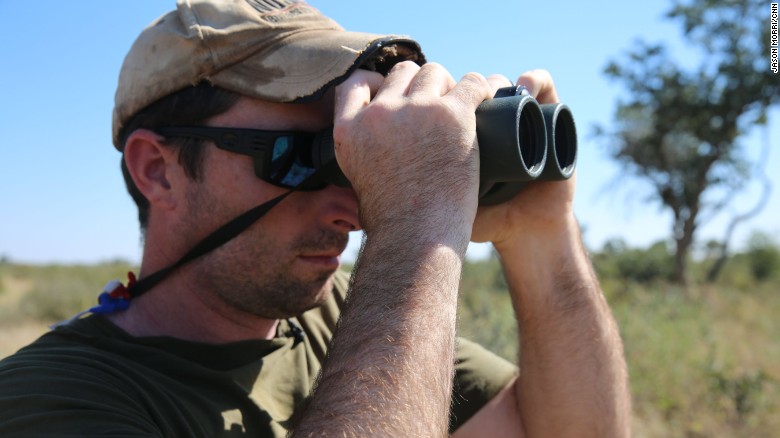
Dallas hunter Corey Knowlton paid $350,000 for a rhino-hunting permit, one of three granted per year by the Namibian Ministry of Environment and Tourism.
Knowlton, 36, from Dallas, wants the world to see that the hunt of such a majestic beast on the African continent is not the work of a bloodthirsty American hunter but a vital component of Namibia's effort to save the animal from extinction.
Knowlton's $350,000 will go to fund government anti-poaching efforts across the country. And the killing of an older rhino bull, which no longer contributes to the gene pool but which could harm or kill younger males, is part of the science of conservation, he argues.
That's why he says he's doing more to save the black rhino than his critics, and why he wanted us along on this historic hunt.
Opponents like the International Fund for Animal Welfare have not been swayed, saying hunting as conservation is a bankrupt notion. "We'll simply never agree with that," fund director Azzedine Downes said. "There's a lot of other things that we can and must do in order to protect these animals."
The journey of this hunt will examine the emotional debate raging around the issue of how best to protect endangered species on a continent that is home to some of the most legendary animals on the planet.
"I think people have a problem just with the fact that I like to hunt," Knowlton said. "I want to see the black rhino as abundant as it can be. I believe in the survival of the species."
Thursday, May 14 -- Learning what to do if the rhino charges
Northern Namibia -- The hunt sets off with a sunrise flight to the region of Namibia where Knowlton will track a black rhino.
There's a great deal of concern about news coverage of the hunt in Namibia. We've been told that when our reports are broadcast around the world that Namibian government officials fear poaching syndicates will use the information to identify the location of other black rhinos.
For that reason, we have agreed not to report the specific locations of the hunt. According to animal conservationists, there are approximately 5,000 black rhinos in the wild worldwide today, 2,000 of them in Namibia.
Hentie van Heerden is a professional hunter hired by the Namibian government to guide Knowlton on the highly scrutinized hunt of the black rhino.
Van Heerden, 40, has an international clientele, mostly from Europe, who come to hunt wild game and the exotic animals of Africa.
He was born in Namibia and grew up hunting. The thorn-infested terrain in the north of the country does not faze him. He wears sandals even when he hunts the wildest of animals.
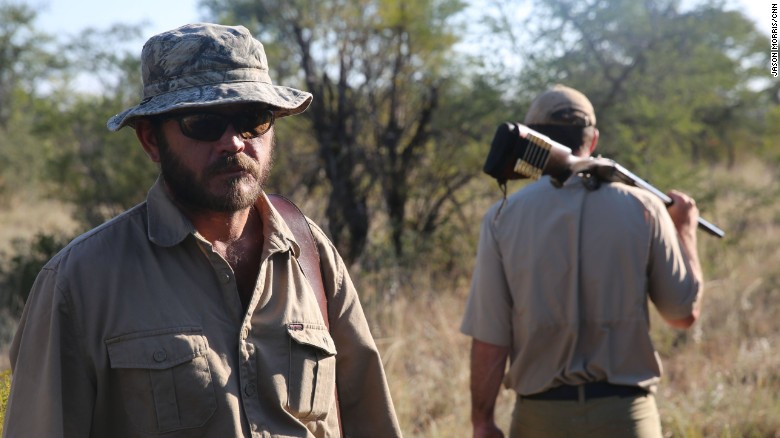
Professional hunter Hentie van Heerden had advice if a rhino charges: Get out of its way.
The bearded van Heerden has the dry sense of humor of a skilled hunter teaching a journalist what to do if we are to stare down a charging rhino.
"The aim is to get out of its way without him flattening you," he said. "It's very rare that they come back for seconds and if that is the case, you have to get some more out of its way."
Van Heerden says there are a few critics of the black rhino hunt in Namibia, but most people here embrace a culture of hunting.
"There will always be activists and that's how they make their money," he said. "They have no clout here in Namibia, because people understand hunting."
The hunt is sanctioned and monitored by Namibia's Ministry of Environment and Tourism. It has identified 18 black rhinos across the country that meet the criteria for being hunted and eliminated.
The rhino must be an older rhino that is no longer reproducing and is considered a threat to younger, healthier rhinos.
Rhinos are intensely territorial and will often kill each other in gruesome fights.
Knowlton is targeting one of four black rhinos at the top of the government list, the ones considered "high priority threats to the herd."
But identifying these rhinos in the dense brush and in the heat of a dangerous hunt makes Knowlton uneasy, though he will have the help of local trackers and guides.
"If it charges at us and we are already sure it's the right one, we are going to kill it," Knowlton said. "If we aren't sure if it's the right one, we are going to try and get out of the way. If we don't feel like we can get out of the way, we got to kill it."
That would be the worst-case scenario for Knowlton. For him, the rhino hunt must be carried out flawlessly.
Friday, May 15 -- The hunt begins
Northern Namibia -- Just after sunrise, Knowlton arrives at a watering hole hidden deep in the Namibian brush to start the hunt. Two government trackers have spotted signs of a rhino heading away from the water.
The footprint appears fresh. The weathered wrinkles of the rhino's hide are still visible in the print. The intricate details in the sand suggest the tracks are just a few hours old.

Prints on the ground are used to track and hunt endangered black rhinos.
The government tracker says, based on the footprints, he can tell this animal is probably one of the black rhinos Knowlton has been permitted to hunt, and that the animal is probably no more than 5 miles away.
This is where the hunt begins.
The trackers move quickly through the thorny bush and tall grasses. They rarely speak. Quick hand signals are all they need to show the path to follow.
Silence is vital when you're tracking a black rhino.
The hunting party winds its way through the brush. The rhino's footprints suggests the nearly 3,000 pound (1,360 kilogram) beast is meandering, which tells the hunters it does not feel threatened.
As the heat of the day intensifies, rhinos will usually find shady areas to take quick naps.
The ranger from the ministry who is observing and leading the trackers says the hunting party is gaining ground on the rhino.
But the brush is so dense. Knowlton worries that we could stumble across the rhino at any moment and end up face to face.
"I think people think of it as this docile thing," Knowlton said of his prey. "But you are dealing with an extremely athletic animal that can do whatever it wants to you very quickly."
The only sounds are the brushes and scrapes of the hunting party cutting through the thorn-infested bushes of this terrain. It seems like every bush has wicked thorns that rip across our skin and clothing.
Rhinos have an intense sense of smell and hearing that alerts them to danger from hundreds of yards away. The winds are swirling in the early afternoon hours and the tracker says the rhino can probably sense our presence and is moving away quickly.
Knowlton is more concerned with something else. He's been told there are three rhinos known to inhabit the area he's in, but the Namibian government has only authorized the hunting of two of them.
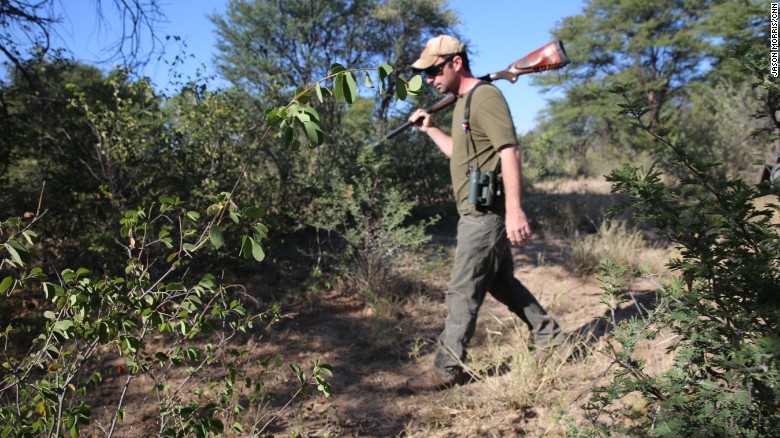
Hunter Corey Knowlton in the thick, thorny brush of Namibia.
Visibility in the brush around us is down to about 15 feet (4.6 meters.) Knowlton is worried that if the rhino charges through the thick brush that he would only have a split second to decide whether to take the shot.
It's becoming too risky. We've spent five hours trekking nearly 6 miles through the brush when Knowlton and his hunting partner decide to call it a day.
Killing the wrong rhino, Knowlton said, would be a catastrophic mistake.
Last year, one of Knowlton's critics suggested the trophy hunting of a black rhino was like shooting a couch in a living room.
This criticism annoys Knowlton endlessly. He's quick to bring it up with a heavy dose of sarcasm.
"So this is just like hunting a couch? Give me a break," he said. "This isn't easy. It's brutal."
Saturday, May 16 -- Change of plan
On the road to southern Namibia -- Knowlton decides the hunt in the north is too treacherous. The brush is dense and visibility low.
That's a dangerous combination for the hunting party and Knowlton knows that killing the wrong rhino will make him an even bigger target of international outrage.
He and his hunting guide decide to drive to southern Namibia to target another dangerous black rhino that lives in a region with better visibility.
But on the way we hear that rhino has died, probably of natural causes.
Sunday, May 17 -- Back again
Northern Namibia -- Knowlton returns to the region that makes him the most nervous. And on this morning, the trails are not strong.
The trackers have trouble finding prints leading away from the watering holes where the rhinos drink vast amounts of water.
![]()
Trackers search for rhino prints near a watering hole.
It's clear the rhino hunt will not end today.
Monday, May 18 - Meeting an angry rhino
Northern Namibia -- The morning starts with a startling discovery. Knowlton's professional hunting guide has discovered a camera image showing a rhino at a remote watering hole just before sunrise.
The image is stunning. The rhino is more massive than I expected. Its horn is long with a lethal pointed tip. Knowlton spots a large gash in the rhino's ear. It's a crucial identifying mark that tells him instantly this rhino is on the approved government list to be hunted.
The hunting party quickly picks up the tracks and disappears into the vicious African bush.
The rhino footprints are fresh and light on the sand, telling the trackers the animal is slowly walking, eating grass and taking naps in the shade to avoid the rising sun.
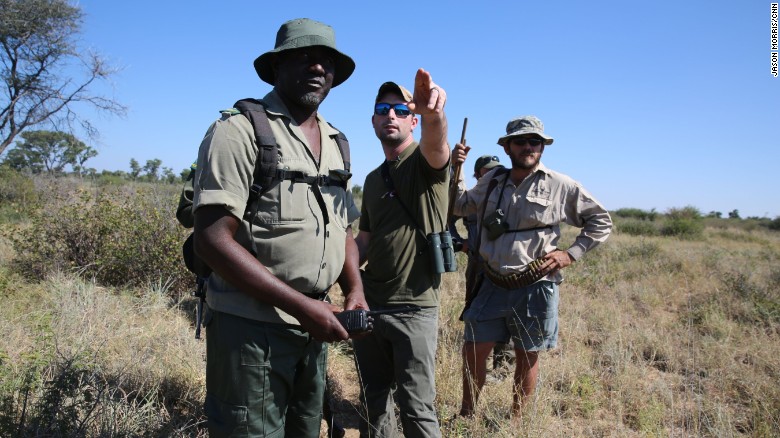
Corey Knowlton, center, with the hunting party.
Today feels different. There's a sense that just beyond our view we are close to the rhino. The hunting party stops to drink water in the shade of a tree for 20 minutes.
When the tracking resumes, Knowlton discovers the spot where the rhino had been resting not moments earlier. You can see the imprint of its wrinkled hide still fresh on the sandy ground.
The rhino is close. Knowlton's hands firmly grip his high-powered 500 Nitro Express rifle. Moments later, I see a massive flash of gray leap up over the bushes some 50 feet in front of us. It disappears and you can't tell which direction the rhino is running.
It's jarring to see this close how quickly these massive creatures can move.
I remember the advice van Heerden, the professional hunting guide, gave me the day before.
"You can't outrun the rhino," he said. "If it means to dive into a thorn bush to the left or to the right, we need to get out of its way in a big hurry."
Now we can't see the rhino, but we know it's close.
Van Heerden tells Knowlton, "He's angry. The next time he will charge."
Twenty minutes later as the hunting party moves through the brush, I hear a sound I've not heard before during our trek.
The rhino is moving around but it's invisible. It's impossible to grasp how such a beast can move like a ghost in the brush.
The hunting party moves single file through a tree line. As the last member of the group emerges, he looks to his left and no more than 40 feet away the rhino is there, staring straight at us.
"There it is!" says the last member in the group.
It's a breathtaking sight. But this isn't the time to stand and stare. I cut to one side and the rhino starts charging in my direction.
"Ed! Get down!" shouts van Heerden.
I rush behind Knowlton and his hunting guide.
"As soon as you dropped below my gun, I could see the whole animal right behind you," Knowlton would tell me later.
I turn around and for a quick flash only see the top half of the rhino in front of us. Then four shots explode through the air.
The rhino has been hit at least three times.
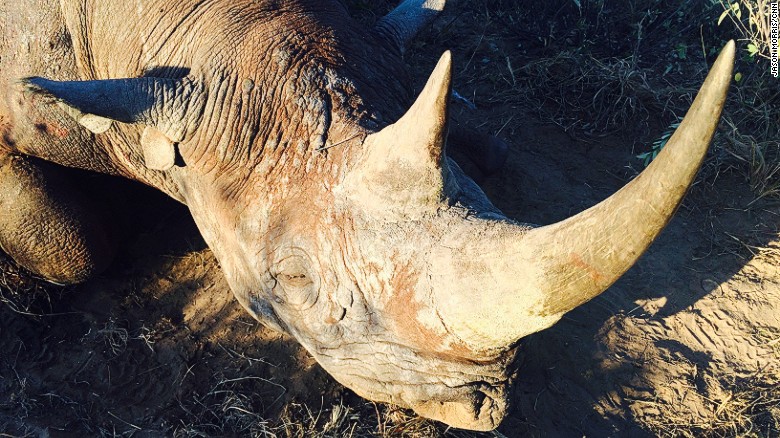
The rhino hunted by Corey Knowlton.
The hunting party then makes the final push to find the rhino. I've lost track of time. This last push might have taken 30 minutes, it might have taken an hour. It was an incredibly emotional experience.
A tracker climbs into a tree and spots the rhino in an open field about 100 yards away. Knowlton gets into position and fires the final shots. The black rhino is dead.
Knowlton walks up from behind the rhino and when he's certain it's over, he kneels next to it.
"Any time you take an animal's life it's an emotional thing," Knowlton said.
The Namibian government official assures Knowlton it is the rhino on the approved hunting list. The trackers smile with relief and shake hands.
I ask Knowlton if he still feels that killing this black rhino was the right thing to do and that it will benefit the future of this endangered species.
"I felt like from day one it was something benefiting the black rhino," Knowlton reflected just moments after the hunt ended. "Being on this hunt, with the amount of criticism it brought and the amount of praise it brought from both sides, I don't think it could have brought more awareness to the black rhino."
News Courtesy: www.cnn.com











